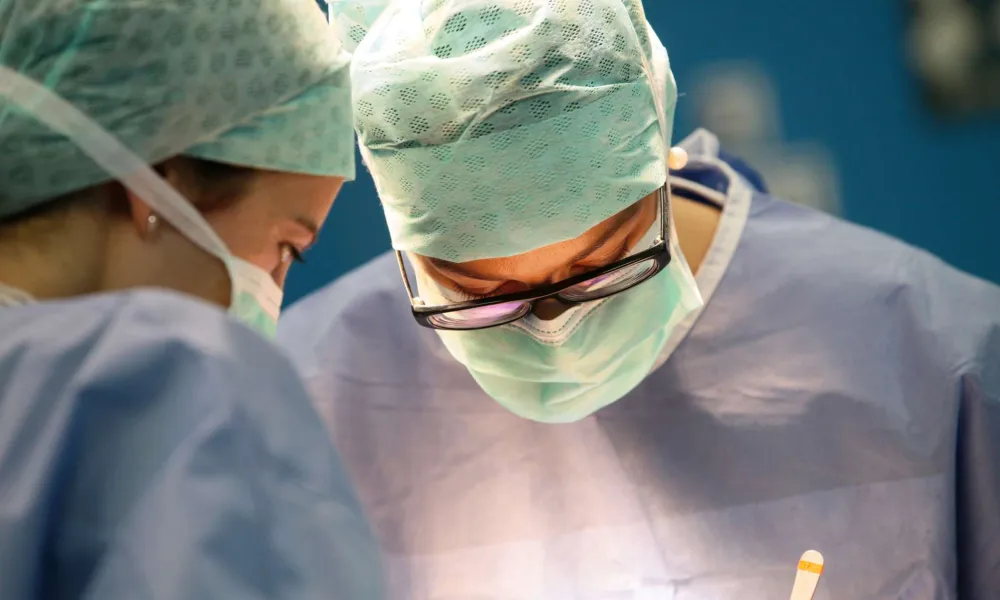
Total Knee Replacement Surgery: The Process
Total Knee Replacement Resources
The Process
Replacing the worn out surfaces of the end of the thigh bone (femur) and top of the shin bone (tibia) and undersurface of the kneecap (patella) with metal and polyethylene (hard plastic) bearing surfaces. We use both fixed-bearing and mobile-bearing prostheses to maximize motion and longevity. This is done to relieve the pain associated with arthritis of the knee. This requires an inpatient hospital stay of 2 to 4 days. The procedure takes approximately 60 to 90 minutes to perform. A system of specific instruments, along with the use of computer-assisted techniques, are used to insure correct placement and alignment of your prosthesis. The implants are fixed to your bones with bone cement. Ninety to 95 percent of patients are happy with their procedure.
What is the Process?
- Make the decision to have surgery.
- Pick a date for your procedure.
- Pre-op medical evaluation with a primary care physician and consults as needed.
- Pre-op labs and tests within 3 weeks of surgery.
- Attend informational seminar at the Center for Joint Replacement.
- Donate blood, if indicated, 3-4 weeks prior to surgery.
- Arrange for family and/or friends to assist you after you go home from the hospital.
The Day of Surgery
What to Bring
- Walking shoes with rubber soles or tennis shoes. No house slippers.
- Pen and pad of paper to write down questions you may have.
- Personal care items.
- Women: Gowns and robes; knee length only. Bring panties. May wear shorts, sweatpants, and T-shirts, or a hospital gown with a robe, if you prefer.
- Men: Short pajamas or exercise shorts and T-shirts. May prefer hospital gown with a robe. Bring underwear.
- Do not bring over $5.00 or jewelry, credit cards, or other valuables.
Report to
The outpatient surgery area of the hospital at the time designated on your surgery checklist. A nurse will review your medical history.
The Preoperative Area
You will change into a hospital gown. An IV will be started in your arm. You will receive fluids and antibiotics prior to your surgery. You will meet the anesthesiologist. He/She will discuss the options for anesthetic. These include a spinal, which numbs you from the waist down, or a general anesthetic. If you elect to have a spinal, medicine can be given through your IV so you sleep during your operation. You may also have a femoral nerve block, which is performed after you are asleep, to assist with postop pain management. Your family and friends may wait with you, until your nurse takes you to the Operating Room.
Arrival at the Center for Joint Replacement
- After you spend 1-2 hours in the Recovery Room, you will be transferred to the Center for Joint Replacement, where your family and friends can visit you.
- The nurses will check your vital signs and pain control. If you are uncomfortable or have nausea, medications will be given to help.
- A therapist will evaluate you and begin therapy, including sitting, standing, and walking. Patients who return to the Joint Center in the late afternoon will begin therapy the next morning.
The staff at the Center for Joint Replacement specialize in the care of patients with joint replacement surgery. They will make sure your recovery goes as smoothly as possible.
Waking Up After Surgery
You will wake up in the Recovery Room, and then will be taken to your room. There will be several things connected to you.
- IV (intravenous line): This is a tiny catheter which is inserted into a vein in your hand or arm. It will be connected to a tubing and a bag of fluids.
- OXYGEN You will have oxygen through a tubing with two small prongs into your nose. This doesn't mean that you are not breathing well. The oxygen may be discontinued the evening of surgery or the following morning.
- FOLEY CATHETER: A catheter may be inserted into your bladder during surgery. It will stay in for approximately one to two days.
- DRAIN: You will have a drain tube into the knee after surgery. This removes excess blood from the knee after surgery. It will be removed the second day after surgery.
- P.C.A. (Patient Controlled Anesthesias) MACHINE: This is a machine which may be used for your pain medication. It connects by tubing to your IV line. Attached to a small IV pole is the machine which contains a syringe of pain medicine. There is a button on a cord from the machine that will be within your reach. When you are having pain, push the button, and the medicine will deposit directly into your vein. This is a small dose. Therefore, you may have it often, if you need it. The machine is programmed so that you cannot give yourself too much medicine. You may take pain pills along with using the machine. This machine will be disconnected when the pain pills will relieve your pain.
- KNEE IMMOBILIZER: Your knee will be in a soft splint after surgery. This will be worn at night when you're not on your CPM and during the first 2-3 days to assist with walking. After Day 3, you will wear it at bedtime only to promote straightening. This will continue for 2 weeks after surgery.
- BREATHING: The nurse will be asking you to take deep breaths and to use your spirometer, which is a small machine that you breathe into in order to clear your lungs.
- DIET: You will be on a regular diet after surgery.
The Remainder of Your Hospital Stay
DAY 1 (the day after surgery)
- Your oxygen will probably be removed.
- Your operative leg will be put in a continuous passive motion machine, which will help you bend and straighten your knee. If you are out of the machine at night, your knee immobilizer will be put on to promote straightening.
- The nurse will encourage you to lift your leg off the bed. It may be a few days before you will be able to lift your leg on your own.
- You will get up to a chair with the assistance of the nursing staff. A soft splint will be on your leg to support it when you get up. When you can lift your leg off the bed on your own, the splint will be discontinued.
- Your exercise program with the physical therapist will begin, helping you to bend, straighten and gain strength in your new knee. You will begin walking with your walker with the physical therapist.
DAY 2
- If you have a drain, it will be removed by the nursing staff in the morning.
- Your IV will probably be discontinued, and the needle will be capped for a few days.
- Your exercise program will continue twice daily, helping you to bend, straighten and gain strength in your new knee. You will continue to walk further each day with your walker.
DAY 3-4
- You will continue physical therapy twice daily. When you can get in and out of bed alone, walk safely with your walker, and you have shown that you can climb stairs, you will be able to leave the hospital. This is usually the 3rd or 4th day after surgery.
YOU are the most important player on your team of caregivers. Your doctor, or one of his assistants, will be seeing you daily, and your nurses and therapists will play their roles in supporting your care. Only YOU can do what needs to be done to make your knee its best.
Your hard work will be worth it!



